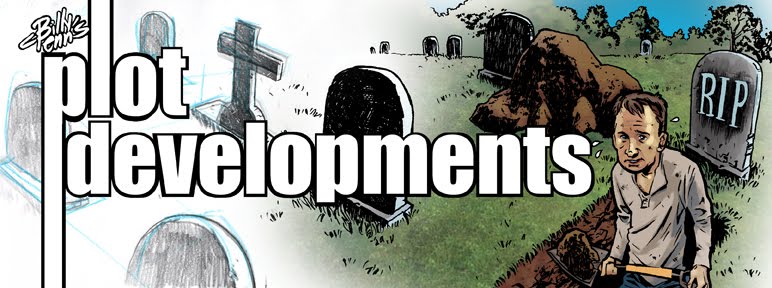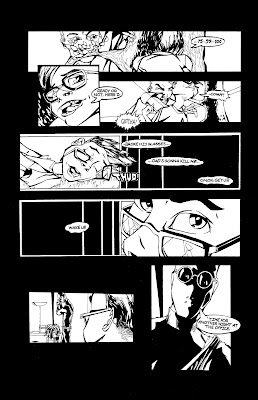Thursday, August 31, 2017
Tuesday, August 29, 2017
Sunday, August 27, 2017
Friday, August 25, 2017
Wednesday, August 23, 2017
Monday, August 21, 2017
Saturday, August 19, 2017
Thursday, August 17, 2017
Twenty Years Ago...(Darkest Places#1 Cover)
I've always felt a little jilted when the art on the cover of a comic book didn't match the interior. I'm a little more forgiving with anthologies that don't have a dominant artist. Many times a publisher will hire a fantastic cover artist that is light years ahead of the artist drawing the actual book. I've always liked it when my favorite artists are able to paint the covers of the books they are drawing. I consider them more "artistic" if they can pull that off. In 1997 I particularly appreciated when artists like Brian Stelfreeze and Tony Harris did that. If you look at Flash Trotter covers, I still feel the same way.
Tuesday, August 15, 2017
Twenty Years Ago...(Darkest Places #1, 1997)
So it’s 1997. I had just graduated from High School and I’ll
admit, I took it just seriously enough to get by. I had arrogantly assumed I
would be a professional comic book artist before I left middle school. In
seventh grade, Image Comics had launched, and I assumed I would be one of them
in no time. I was an impressionable twelve year old who didn’t know better. Early
in high school, I rememeber Wildstorm Studios put an ad in the back of “WildC.A.T.s”
#2 looking for new talent. Talent (or lack of) aside, I didn’t even qualify
past the cut off age of 17. But I thought I was close. Soon afterwards,
Wildstorm embarked on their “Killer Instinct” tour. My friends and I waited in
line outside of the Cosmic Cat 2 just staring at the biggest tour bus we’d ever
seen. These guys were ROCK STARS. As a fan/teenager/aspiring artist, I wanted
in. There’s a HUGE difference between being a fan who can draw (decently) and
being a professional comic book illustrator. It’s a little embarrassing how
long it took for me to learn that particular lesson.
By the summer of 1997, I was a high school graduate. I never
did get to drop out or strike out on my own. That window had closed. I didn’t
have ambitions of going to community college, university, degrees, marriage,
house and kids. I just loved comic books and pop story telling. And I figured I
could just “do it.” I hung out with a select few like-minded friends. Since they
didn’t draw they could write. That’s how it works, right? Easy.
High school had come and gone, and I had never drawn a
complete comic book. I had drawn the occasional three page sample story, but
never anything close to a twenty-four page comic. Maybe I silently harbored the
blame on my “writer” friends. For some reason, creating comic books isn’t in
any high school curriculum. It wasn’t a priority for anybody that I knew. The
only place it mattered was at Dragon Con(s) 95/97 and my own imagination. Even
those never happened with enough regularity.
I had taken sample pages of Spider-man to those, but they were less than
“Amazing.” Not even “Spectacular.” My idol, Brian Stelfreeze gave them an better
and more thought-out critique than they deserved. I remember him talking about
the lack of “set-up” and “pay-off” the visual storytelling was missing. Unlike John
Woo’s” Face/Off” that he had seen the night before.
The summer of 1997 heralded the ending of another era. Oak Lake
Six, the home of my first job, the movie theater that I considered my TRUE education,
was closing. Co-workers whom had graduated the year prior, had returned from
college to their old sumer jobs. One of them, Mr. Jake Pinholster was a friend
from both the movie theater and high school. Outside of either of those things,
our circles never really crossed. The impending closure of the theater gave me
a movie making itch that I had to scratch. I storyboarded an intimate little
character piece full of nuanced performances. Kidding. It was the James Bond
action stinger/opener for “Golden Balls.” I gathered friends together and we
filmed around a dying movie theater. You might notice the Speed 2: Cruise
Control, Disney’s Hercules, and Face/Off populating the background in the
not-so-kinetic shots. In between shots, Jake and I talked about following
creative impulses, writing, and art and at some point he mentioned a story he
was working on called “Darkest Places.” Jake had come back from a year at UF
working on a theater degree. I think he envisioned “Darkest Places” as a play,
but I was interested in making into a comic book. Why not? I’d always wanted a
friend to write something for me to draw. I had a pack of twenty-four Blue Line Pro pages
just waiting to be used in “one big go” (and not chipped away at as failed
samples.)
Jake gave me outlines for what would become the first (and
last) two issues. I measure all other assignments by the excitement I felt
reading these. I would later find out that this is what is considered “Marvel
Style.” I had never seen or considered this as anything other than your typical
format. Since then, I’ve come across every type of script you can think of. I
loved the fact that the pacing was completely up to me. I had complete freedom
when it came to character design. I could “cast” whoever I wanted. I sat in class and daydreamed about every
aspect of the story. This was like my first real directing gig and the only
thing that I was limited by was my imagination and drawing ability. Much of my “preproduction”
art was inspired by the “ART of…” books by Pixar studios. I was always taken by
their lush colors, energetic sketches, and dynamic color schemes that were so
much more impressionistic than what the computer would eventually render. Come
to think of it, I only owned the “Art of Toy Story” by 1997. Dang. I took some
reference photos, I penciled and inked the entire thing, and I did almost all
of it at TCC. In school and in between classes I would walk into the library
ready to work. Pencilling and inking (and NOT studying) was very theraptic. All
I really needed was a desk next to a wall outlet so I could plug in my Sanyo
Portable CD player with anti-skip (I had given up on batteries.) Everclear’s “So
Much For the After Glow,” Radiohead’s “O.K. Computer” and Faith No More’s “Album
of the Year” and the “Lost Highway” soundtrack were my co-workers. If I was
lucky, my “office” even had a window view. While other kids were in studying
and jumping through hoops for other people, I was doing something even better:
I WAS CREATING! (Co-creating, if I’m being completely honest.)
As I thought about this retrospective article for the months
of Aug/Sept, I thought I’d make a pilgrimage to the old library. TCC is close
to the Kia dealer when I get my oil changed. Walking around TCC on a July Saturday,
it’s funny how much things change but still feel the same. I don’t get
nostalgic for “simpler” days, but I do miss being younger. Staying in the same
town my whole life, it’s weird seeing things grow. Chiles High School (the most
current high school in town) is like the TCC of 1997. TCC 2017 is more like the
FSU of 1997. FSU 2017 is practically it’s own city. John Lakin (Jake’s co-thug
in “Goldenballs”) told us that college is just “high school with ash trays.” By
2017, those days are gone. Good riddance. Walking into the TCC library, I was
struck by how much of it hadn’t changed. The front entrance got a facelift (but
I was there for that in 1998/99.) The carpet is the same. The shelves are the
same. Even the desks are the same. This biggest difference I noticed was that
the students have more tattoos and absolutely NONE of them are looking for
outlets to plug in their portable CD players.
Sunday, August 13, 2017
Friday, August 11, 2017
Wednesday, August 9, 2017
Tuesday, August 8, 2017
Saturday, August 5, 2017
Thursday, August 3, 2017
Tuesday, August 1, 2017
Subscribe to:
Posts (Atom)





















